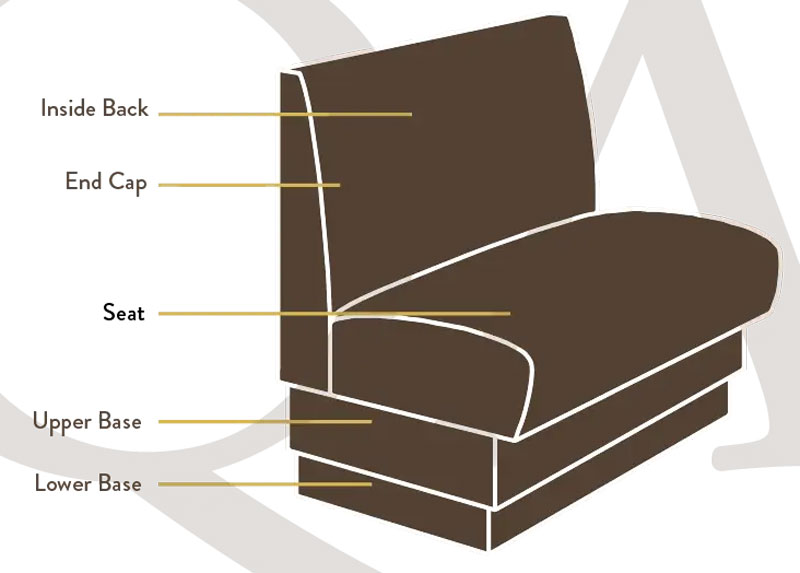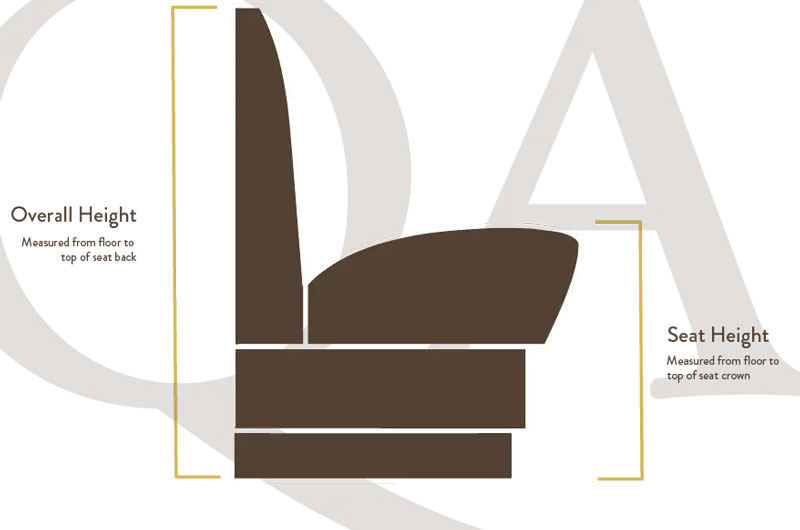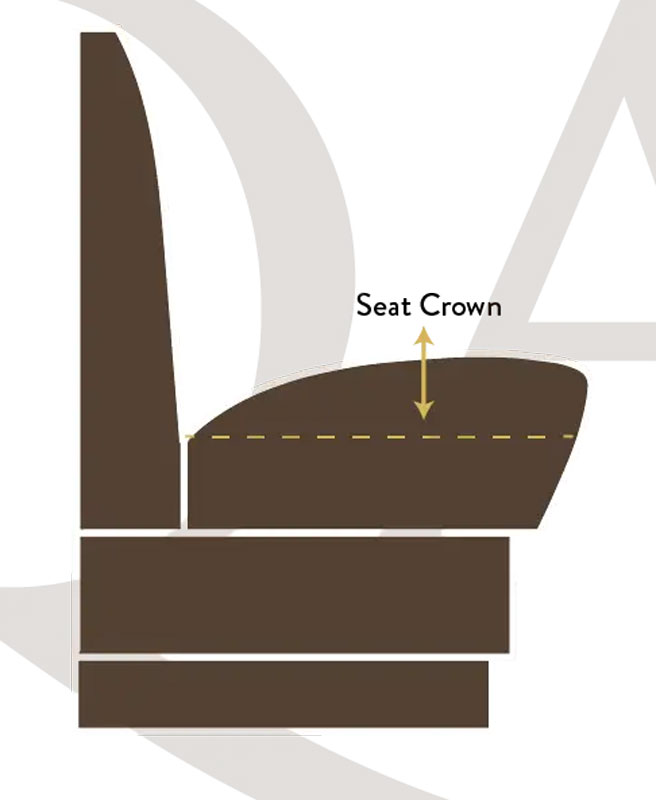| Armoire | The French version of the wardrobe. A freestanding closet, usually with shelves and/or a hanging rod. Differs from a wardrobe in that a wardrobe often has drawers beneath the closet section. | xx |
| Bachelor's Chest | A small chest of drawers, usually 24" to 36" wide by 30" to 36" tall, sometimes used in pairs. | xx |
| Booth/Banquette | Banquette seating is a long bench, typically built against a wall, providing an open straight seat. Booth seating configures banquette benches together to create an enclosed space.
   | |
| | | xxxxxxxxxxxxx | The Base | The base of your booth or banquette serves as the essential foundation upon which everything else is built, consisting of two key parts: the upper base and the lower base. You need to recognize the importance of this structure, as it must be both sturdy and durable to support the entire seating arrangement. The lower base, also known as the recessed base or toe kick, provides a solid foundation for the banquette while also making housekeeping easier by preventing objects and dust from accumulating underneath. This base is typically recessed to allow for comfortable foot and heel placement while seated. The depth of this recess can be customized, but it must be carefully designed to ensure the seating remains stable and doesn’t tip forward. The upper base, or apron as some call it, acts as a separation between the lower base (or legs) and the seat. It can serve as a decorative element or as a functional component where a removable seat rests or where the legs connect. Depending on design preferences, the upper base can feature exposed wood or be fully upholstered. While not always a necessary component—since some banquettes have tight seats extending directly to the lower base—it adds a unique touch to the overall look. A variety of options for both the upper and lower bases, include different heights, materials, and finishes. Choice of base will significantly influence the look and functionality of the seating, making it an important aspect to consider in the overall design. | | xxxxxxxxxxxxx | The Seat | The seat of the banquette is where comfort and functionality come together, making it a crucial element in the overall design. Whether it’s an upholstered seat with cushioned support or a solid surface like exposed wood, the seat’s design impacts both comfort and durability. There are a range of seating options. Most upholstered seats include a support system consisting of polyurethane foam over steel springs or simply foam over a solid substrate, such as upholstered pads. Designs are crafted with precision, considering factors like seat height and firmness to ensure an optimal experience. If the seat is too high, guests may find their feet dangling uncomfortably; if too low, they may struggle to get up. The right firmness is also essential—too soft, and the fabric may stretch prematurely; too hard, and guests might not want to sit for long. The use of only the highest-quality materials to construct should be considered. For example, “no sag” sinuous springs in upholstered seats to guarantee durability and comfort. While cheaper methods like webbing may seem cost-effective, they often lead to premature wear and tear, resulting in additional maintenance or even failure over time. | | xxxxxxxxxxxxxx | The Inside Back | The inside back of the booth or banquette is a key element that significantly influences both the comfort and aesthetic appeal of the seating. It provides a surface for guests to lean against, and its design is crucial to defining the overall comfort level of the banquette. One of the most important considerations during the design phase is the ratio between the pitch of the inside back, the overall height, and the depth of the banquette. These dimensions must be carefully balanced to ensure the seating fits perfectly within its designated space and provides the desired level of comfort. The inside back of the banquette is often the most visible part of the seating, especially in dining environments where it isn’t obscured by a table. This visibility offers an excellent opportunity for customization. There are variety of design options for the inside back, including tufting, channeling, and various stitching designs. These decorative features can enhance the visual appeal of the seating, making it a standout piece. | | xxxxxxxxxxxxx | The Outside Back | The outside back of the banquette is an important aspect to consider, especially if the seating will be visible from multiple angles. When the outside back is concealed against a wall or other booth seating, it often doesn’t require the same level of finish as the rest of the banquette. In such cases, a simple covering with black cambric is usually sufficient, effectively closing off the back and saving on costs. However, if the seating is free-standing or visible from different sides, the outside back should be designed with the same attention to detail as the rest of the piece. A common approach is to upholster the outside back with the same fabric used for the rest of the banquette, much like how sofa backs are finished. This creates a cohesive look and ensures that the seating is visually appealing from all angles. For a more premium finish, especially in commercial settings, you might opt for wood paneling on the outside back. This not only gives the seating a solid, refined appearance but also adds durability, making it an excellent choice for high-traffic areas. Just like the inside back, the outside back can be customized with various materials and finishes to perfectly match overall design vision, ensuring that banquette is a standout piece from every perspective. |
| |
Casegoods/ Case Pieces
| Furniture, including chests, dressers, china cabinets, desks and bookcases, designed to store clothes or other objects. | |
| Cedar Chest | A rectangular chest built of or lined with cedar in order to keep blankets and linens protected from moths and other insects. Aromatic properties of cedar serve as a natural pest deterrent. | |
| Club Chair | A short-backed, armed and upholstered comfortable chair. | |
| Credenza | A serving table with doors below, much like a buffet. Has evolved to be used in offices, providing a work surface and storage. | |
Étagère | A storage and display piece with open shelves to showcase collectibles and other small items. | |
Highboy | A tall 18th Century American case piece with four or five drawers, a cornice or pediment crown and a legged base. | |
Lowboy | A dressing or serving table or a low chest of drawers, set on legs, originating in 18th Century America. | |
Pedestal Table | A tabletop supported by a single or double pedestal base. | |
Secretary | A slant-top desk with a chest base and door hutch developed in the late 17th and 18th Centuries in England and America. Also known as secrétaire. | |
Settee | The predecessor of the sofa, developed as an elongated arm chair. May be wooden or upholstered. | |
Sideboard | An auxiliary dining room case piece used for serving with drawers and cupboards for storage. | |
Windsor Chair | A wooden chair design featuring a curved back with thin spindles and a saddle seat. | |
Wing Chair | A high-back, upholstered easy chair with panels or wings projecting forward from the sides of the back and curving downward to meet the rolled arms. The wings were originally designed to protect a sitter from drafts, and the style has remained popular since the late 17th Century. | |



